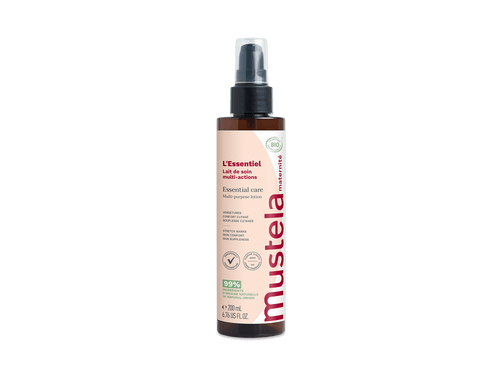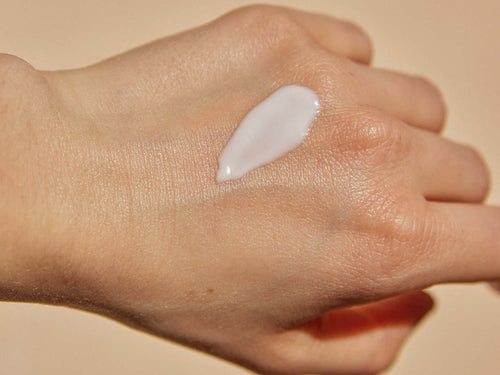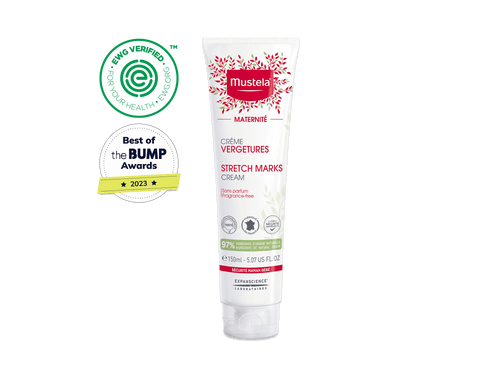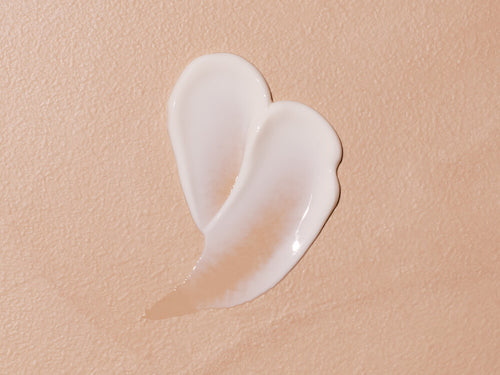Pregnancy is both exciting and nerve-racking. It’s exciting because you’ve got a wonderful little life growing inside you, but it’s nerve-racking because your body is going through a lot of changes to make that life possible.
One of the earliest changes you’ll experience is dry skin. And if you’ve never dealt with dry skin before, it can come as quite a shock.
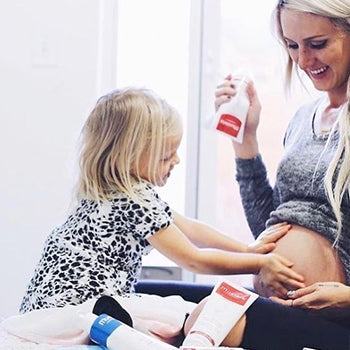
Let the experts at Mustela calm your nerves and show you how to treat and prevent dry skin during pregnancy. After we introduce you to a bit of skin science and investigate the causes of dry skin, we’ll answer these common questions (and more):
- Should I wash with hot, warm, or cool water?
- Should I exfoliate, and if so, how often?
- When should I moisturize?
- Do I need to use a hydrator?
- When should I call my doctor?
Before we answer those questions, though, let’s learn a bit about your skin and what causes it to become dry during pregnancy.
Skin Science
Your skin is composed of many layers. The three main divisions from inside out are the:
- Hypodermis.
- Dermis.
- Epidermis.

Each of those main divisions can be subdivided into smaller layers. For the purposes of this article, we’ll be focusing on the outermost layer of your skin, the epidermis. More specifically, we’ll be zeroing in on a small layer of the epidermis known as the stratum corneum. The stratum corneum is the part of your skin that is exposed to the air around you. It’s the part you can see with your naked eye.
On top of the stratum corneum is a layer of water, fat, and wax called the hydrolipidic barrier. The purpose of this oily barrier is twofold:
- To keep toxins like dust, dirt, pollen, and pet dander away from the stratum corneum.
- To prevent moisture from evaporating off the surface of your skin.
It’s this last purpose—moisture evaporation—that we’re most concerned with today. That’s because when the hydrolipidic barrier breaks down, dry skin rears its ugly head. Let’s investigate this in a bit more detail.
The Causes Of Dry Skin

The hydrolipidic barrier is sensitive to all kinds of internal influences. It can also be affected by external factors, but for the most part, the hydrolipidic barrier is controlled from inside your body.
Primarily amongst those internal influences are disproportionate hormone levels. And what is one time in your life when your hormone levels are up and down every day? Pregnancy.
When hormone levels begin to fluctuate, the hydrolipidic barrier can thin, weaken, and even break down (form holes) in spots. These “holes” allow moisture to evaporate quickly off the surface of your skin. This results in dry, cracked, itchy skin.
Think of it this way: the hydrolipidic barrier is like a lid on a pot of water. When the water is boiling inside the pot, the lid prevents the steam from boiling off into the air.
But what if the lid has holes in it? The steam escapes through those holes into the air. That’s what’s happening when you develop dry skin during pregnancy.
So now that you know what causes dry skin, let’s get to the more important part: how to treat and prevent it.
How To Treat & Prevent Dry Skin During Pregnancy
Ultimately, treatment and prevention for dry skin during pregnancy comes down to keeping moisture in your skin. The best way to do this is to preserve the hydrolipidic layer that’s still there, and to use products that can fill in the holes until your hormones settle down.
Here are 10 ways to nurture your hydrolipidic layer and prevent moisture from evaporating off your skin.
1) Wash With Lukewarm Water Instead Of Hot Or Cold Water

Extreme temperatures—be they air or water—can weaken your hydrolipidic layer and, at the same time, steal the moisture that keeps your skin soft and supple. That’s why it’s so important to avoid washing with either hot water or cold water.
Instead, adjust your shower or bath water more toward the middle (lukewarm) of the scale. For those of you who want more precise numbers, think body temperature (around 98.6 degrees Fahrenheit).
For those of you with more sensitive skin, five degrees on either side (about 93 degrees to 104 degrees Fahrenheit) is still considered lukewarm.
2) Avoid Rough Fabrics
Because of a weak or nonexistent hydrolipidic barrier, dry skin is especially susceptible to micro-damage and irritation from external sources. One of the most common sources of irritation is rough fabrics. Thankfully, that’s also one of the easiest variables to change.
When choosing clothing, always put the softest, most breathable fabrics next to your skin. At the same time, try to keep rough fabrics like wool and denim from repeatedly rubbing against dry patches.
And don’t forget about drying off after you shower. Even the softest towels can cause irritation if you rub too hard. That’s why we suggest patting your skin dry instead of rubbing back and forth.
3) Exfoliate Dry Skin Only Once A Week
Exfoliation is an important part of a healthy skincare routine. That doesn’t change just because you get pregnant and develop dry skin. The benefits of exfoliation are vast and include:
- Removing dead cells that can clog your pores.
- Promoting new, healthy skin growth.
- Allowing healing products like moisturizers and hydrators to penetrate deeper into your skin.
What does change when you suffer from dry skin is the frequency with which you conduct your exfoliating. We recommend exfoliating only once per week to preserve your skin’s delicate balance. This will give it time to adjust to the fluctuating hormone levels brought on by your pregnancy.

It’s also important to use a gentle exfoliant so as not to further irritate dry skin. One of our favorite gentle exfoliants is baking soda. We like it because it’s all-natural, easily obtainable, affordable, and can be used on any part of your body.
Check out our article Is Your Skincare Routine Safe For Your Pregnancy? for a great all-natural baking soda exfoliant recipe.
4) Moisturize In The Morning & Before Bed
Remember, the whole reason you’re suffering from dry skin is because moisture is evaporating too quickly. You can work to keep that water on your skin where it belongs by applying a moisturizer in the morning, before bed, and several times in between.
Moisturizers are formulated to set up a barrier between the outside air and your skin to keep water from evaporating (much like the hydrolipidic layer does). But not all moisturizers are created equal...especially for pregnant moms.
That’s why we recommend a pregnancy-safe skincare product, like Mustela’s Body Firming Gel. All of Mustela’s products are:
- Formulated with natural ingredients.
- Hypoallergenic.
- Compatible with breastfeeding.
- Safe for mom and baby.
5) Add A Hydrator To Your Daily Skincare Routine
Contrary to popular wisdom, hydrating and moisturizing are NOT the same thing. Moisturizers form a layer on your skin to keep moisture from escaping.
Hydrators, on the other hand, actually put water into your skin. That’s why they’re so important for treating and preventing dry skin during pregnancy.
When it comes to adding a hydrator to your daily skincare routine, though, the order in which you apply it becomes very important. You should always apply the hydrating product first, followed by the moisturizer.
When employed in this order, the hydrator is in direct contact with your skin where it can do the most good. The moisturizer applied on top of the hydrator then forms a layer over everything, which locks moisture next to your skin and keeps it from evaporating.
6) Treat Stretch Marks And Dry Skin Will Stay Away

Stretch marks are another skin concern you have to contend with when you get pregnant. The nice thing about stretch marks—if anything about them can be called “nice”—is that treating and preventing them often keeps other skin problems at bay...including dry, itchy skin. So if you focus on keeping your skin healthy and stretch mark free, the dryness will disappear as well.
We recommend products like Mustela’s:
7) Protect Your Skin
The sun is extremely drying, so protect your sensitive pregnancy skin!
Of course you know to wear sunscreen while you’re out in the sun, but what you might not know is that it should be applied daily.
Look for a mineral sunscreen with at least an SPF of 15 and one that’s free of chemicals. Our SPF 50 Mineral Sunscreen Lotion, for example, is safe for the entire family and ideal for sensitive skin types.
This fragrance-free, SPF 50 broad-spectrum sunscreen is formulated with 93 percent naturally derived ingredients, including coconut oil, macadamia oil, and vitamin E to hydrate your skin while protecting you and your family from the sun’s harmful rays!
8) Eat Well
Hydrated skin starts from within. And we’re sure you know by now how important it is to eat a healthy, well-balanced diet while you’re pregnant. But did you know that you can help improve your dry skin through your diet? It’s true!
To ward off dry skin, be sure to include good fats in your diet. Check out our list of foods to help combat your dry skin:
- Fish (Be sure to check with your doctor about what types of fish are safe to eat while you’re pregnant.)
- Avocados
- Sweet potatoes
- Nuts
- Seeds (chia seeds, pumpkin seeds, flaxseeds, or sunflower seeds)
- Oatmeal
- Dark chocolate (As if you needed another reason to eat chocolate!)
- Coconut (Not only is eating the fruit beneficial, but applying coconut oil topically is also a great way to treat your dry skin!)
- Vegetables (specifically carrots, broccoli, and cucumbers)
- Eggs
9) Stay Hydrated
The texture of your skin indicates what’s going on inside your body. And just like we said above, hydrated skin starts from within.
This not only includes what you eat, but what you drink as well! Keep skin hydrated and avoid dryness by drinking plenty of water. Water helps your body absorb nutrients and transfers vitamins and other important minerals to your blood cells.
Other benefits of staying hydrated include:
- Maintaining a healthy amniotic fluid level
- Helping your baby’s kidney function
- Dissolving waste and flushing it out of your kidneys
- Keeping aches and pains at bay
During the first trimester, some women have found that drinking water helps ease their nausea, indigestion, and constipation. Drinking water is even more important during the third trimester because you can easily become dehydrated then, which can lead to contractions or even preterm labor.
If you visit your doctor during the third trimester and you’re experiencing early contractions, he or she will advise you to immediately drink water, somewhere around two liters.
Another common symptom in women during the third trimester is swelling. One reason you swell during pregnancy is because your body is harboring extra sodium. Another reason you swell is because you get too hot.
And with all the hormones in your body during pregnancy, it’s easy to get hot quickly! Drinking water not only cleanses your body of sodium, but it also helps keep your body’s core temperature down.
So, to sum it up, drinking water has a domino effect. Your body will be cleansed from the inside while providing hydration to your skin on the outside. So drink up!
Hint: If your urine is pale or colorless, this likely means you're consuming the right amount of water daily, but if it's not, up your intake!
10) Use A Humidifier
Surprisingly, the quality of the air in your home affects your skin, and more than likely, your home has dry air flowing through. The ideal level of humidity in your home should be anywhere between 40 and 60 percent.
To find out the exact measurement of the humidity level in your home, use a hygrometer — a device that measures humidity levels.
Dry air can lead to dry eyes, dry skin, eczema, itchy skin, dry nasal passages that can cause nosebleeds, and cracked lips.
Moisturize the air in your home by using a humidifier. Both types of humidifiers — warm-mist humidifiers and cool-mist humidifiers — are great options for adding soothing moisture to your dry indoor air.
So what’s the difference? A cool-mist humidifier is a great choice for children and pets. A warm-mist humidifier is a little quieter than a cool-mist and can help you feel slightly warmer in the winter.
Both humidifiers will benefit your skin and ease your dry-skin symptoms. Just make sure the humidifier you choose is an appropriate size for your room and that the door is closed while you’re using it. This keeps the moisture in the room from escaping.
Dry Skin During Pregnancy: When To See Your Doctor

Itchy and dry skin can easily accompany your pregnancy, but this doesn’t mean they’re easy to deal with. Sometimes your dry skin can be treated at home, and sometimes you need to see a doctor.
As we discussed earlier, when your skin stretches around your abdomen, you can get itchy red bumps and dryness. This is normal. But when your dry skin continues after two weeks even with proper hydration, reach out to your doctor.
Dry Skin In A Nutshell

As you now know, dry skin is common in pregnancy. You’ve learned all about skin science and the layers of your skin, and you’re familiar with the causes of dry skin. The good news is that you can treat and prevent your dry skin at home!
Just a few of our tips and tricks for at-home treatment include using lukewarm water, avoiding rough fabrics, and exfoliating and moisturizing your skin.
Treating your stretch marks is another way to keep dry skin at bay. Remember hydrated skin starts from within, so eat well and drink water! Use a humidifier to add moisture to your home. And, finally, protect your skin daily with our SPF 50 Mineral Sunscreen Lotion.
For more ways to keep your skin healthy, check out our full line of maternity products. At Mustela, we’re committed to helping you stay comfortable and happy during this memorable time in your life.






